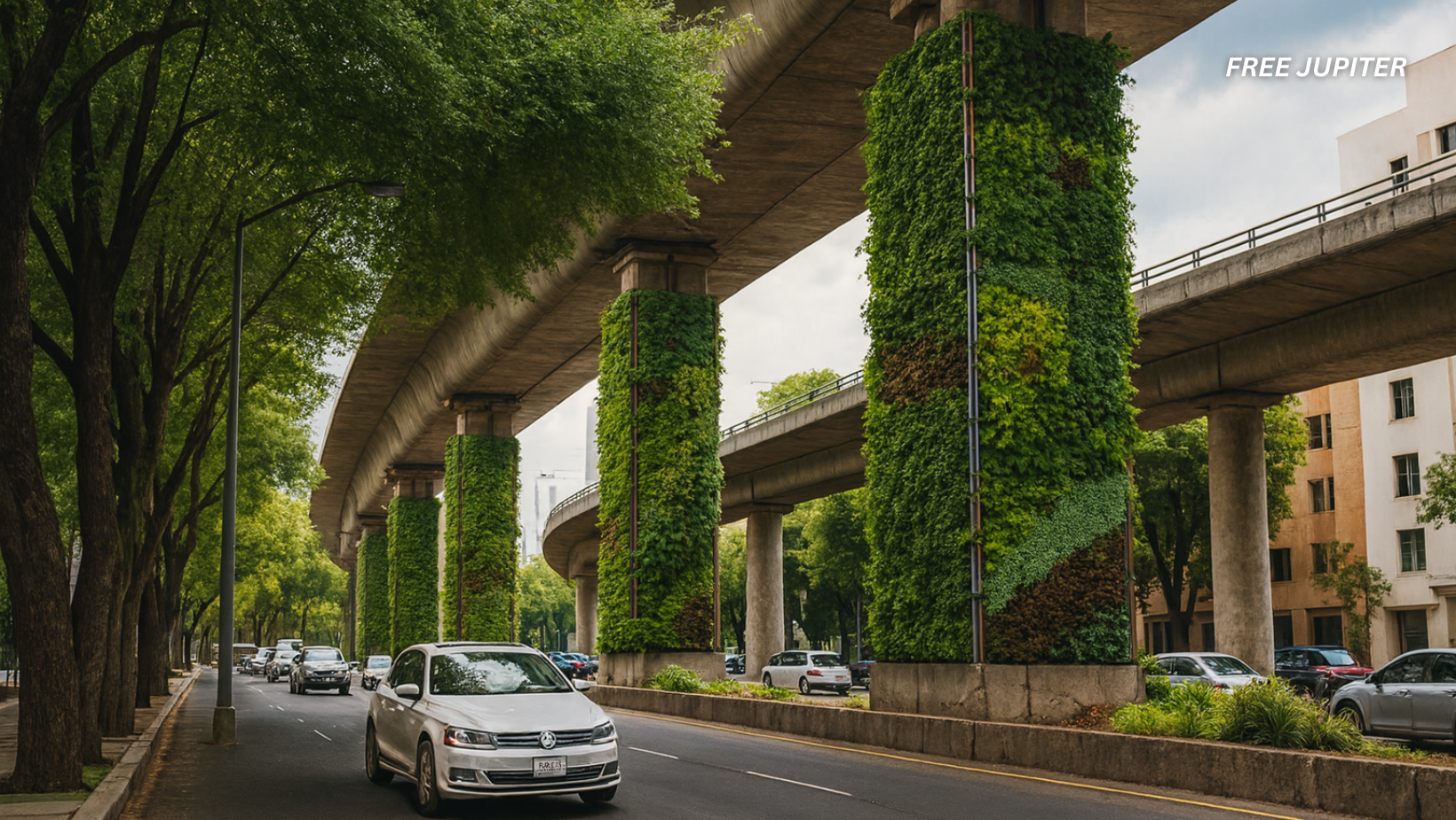Concrete has always been the backbone of modern cities, but no one has ever accused it of being beautiful. It is gray, harsh, and often associated with lifelessness. In a city as massive and chaotic as Mexico City—one of the largest urban areas in the world—concrete dominates the landscape. Highways snake across neighborhoods, and pillars rise like giant stone trunks holding up layers of traffic.
But something unusual is happening along the Periférico, one of the busiest highways in the city. The once-barren pillars are being wrapped in lush greenery, transforming gray slabs into vertical gardens alive with flowers, vines, and leafy plants. Commuters are suddenly finding themselves surrounded not just by cars and fumes, but also by bursts of color and life.
This ambitious project is called Vía Verde, or “Green Way.” It represents a fresh approach to dealing with the challenges of urban living: pollution, heat, noise, and the emotional weight of city monotony. Instead of tearing down concrete, Mexico City is reimagining it—turning its most ordinary structures into canvases for nature.
From Citizen Dream to Citywide Project
Vía Verde began not as a government initiative but as a citizen-led idea. Local environmentalists and urban planners proposed that the countless concrete pillars propping up the Periférico could become more than just lifeless supports. Why not use them to bring greenery back into the city?
The idea resonated with residents, who were increasingly frustrated with pollution levels and traffic stress. Slowly but surely, the project gained momentum. City officials approved, and before long, more than 1,000 pillars across 27 kilometers were included in the plan. Together, they now boast over 60,000 square meters of vertical gardens—an area equivalent to about ten football fields.
For commuters who once stared at endless gray, the change is nothing short of dramatic. Where there was once only concrete and grime, there are now blossoms, trailing vines, and living walls that shift with the seasons.
Read more: “Totally Unexpected” Activity Detected at Supermassive Black Hole Event Horizon
The Hidden Engineering Behind the Green
Covering a highway pillar in plants might sound straightforward—just add soil, seeds, and water, right? In reality, it’s a feat of careful engineering.
Each pillar is covered with panels of felt made from recycled plastic bottles, forming small pouches that cradle the plants. This material is lightweight and strong, ensuring the gardens don’t add too much strain to the existing structures.
Watering is handled by a drip irrigation system that draws on two main sources: captured rainwater and treated gray water (the kind of wastewater that comes from showers and sinks). This design keeps the gardens sustainable without putting pressure on the city’s already stretched water supply.
To prevent waste, sensors track the moisture, sunlight, and nutrient levels of each installation. Crews can then adjust the care system based on real-time data, giving plants exactly what they need. This “smart gardening” approach not only keeps maintenance efficient but also shows how technology and nature can work together in surprising ways.
Can Green Walls Really Clean the Air?
Skeptics might wonder: can a bunch of flowers and vines really solve the smog problem of a city with over 22 million residents and countless vehicles on the road? The answer is complicated.
No one is suggesting that vertical gardens alone will eliminate pollution. But studies show they do have measurable benefits. Plants can capture airborne dust, absorb some pollutants, and release oxygen. Green surfaces also lower temperatures by reducing the “urban heat island effect,” where concrete and asphalt trap and radiate heat, making cities hotter than surrounding countryside.
Another overlooked benefit is noise reduction. Vertical gardens help muffle the constant roar of traffic, creating a quieter environment for nearby neighborhoods. And while the direct impact on smog levels may be modest, the psychological benefits are harder to ignore.
Imagine being stuck in bumper-to-bumper traffic. The air is heavy with exhaust fumes, and the honking seems endless. Then, suddenly, the scene shifts—you pass by pillars alive with greenery, flowers peeking out from the edges, and leaves shimmering in the breeze. Even a small glimpse of nature can ease tension, brighten moods, and offer a mental break from the grind.
Read more: Scientists Discover Reef in Great Barrier Reef Taller Than Empire State Building
More Than Just Decoration: The Emotional Impact
Urban psychologists have long studied the effects of greenery on city dwellers, and the results are consistent: exposure to plants, even in small doses, reduces stress, improves mood, and encourages feelings of calm.
Children riding buses along the Periférico have been seen pointing out the gardens with excitement. Drivers snap photos while waiting at stoplights. Residents nearby report that the presence of green pillars makes the area feel more welcoming and less hostile.
It’s a reminder that cities are not just machines for movement and commerce—they’re also places where humans live, breathe, and feel. Projects like Vía Verde reconnect people to nature, even in unexpected places like a traffic-choked highway.
A City Battling Pollution
Mexico City has long struggled with air quality. In the 1980s and 1990s, smog levels became so dangerous that children were kept indoors, and mountains surrounding the city often disappeared behind a haze of brown air. While significant progress has been made since then—thanks to stricter vehicle regulations and investment in public transportation—pollution remains a major challenge.
This history gives projects like Vía Verde deeper meaning. They are not simply decorative but part of a broader effort to reshape the city into a healthier, more sustainable place.
Lessons From Around the World
Mexico City is not the only urban giant experimenting with green architecture. Around the globe, designers are finding ways to weave nature back into concrete jungles:
- Singapore has become famous for its “supertrees,” towering vertical structures covered in plants and fitted with solar panels. They provide shade, capture rainwater, and act as futuristic ecological hubs.
- Milan, Italy, boasts the “Bosco Verticale” (Vertical Forest), a pair of apartment towers covered with over 900 trees and 20,000 plants, creating a living ecosystem in the middle of the city.
- Madrid, Spain, has added vertical gardens to building facades, including one of Europe’s largest living walls at the CaixaForum cultural center.
- Even smaller cities are joining the movement, with schools, shopping centers, and office complexes experimenting with plant-covered exteriors.
Each project is unique, but they share a common theme: blending urban function with ecological design.
Read more: This Black Fungus Can Break Down Plastic Waste Into Edible Substances
Why Vertical Gardens Matter
Critics may point out that projects like Vía Verde are symbolic gestures rather than systemic solutions. And they’re right—vertical gardens cannot replace the urgent need for cleaner transport, renewable energy, and reduced dependence on cars.
But symbols matter. They change how people feel about their environment, inspire conversations, and encourage citizens to demand more ambitious solutions. By proving that even concrete pillars can host life, Vía Verde suggests that cities need not be lifeless gray zones. They can evolve into spaces where nature and infrastructure coexist.
In other words, these gardens are not the answer—but they are part of the answer.
Featured image: GPT-5o Recreation.
Friendly Note: FreeJupiter.com shares general information for curious minds. Please fact-check all claims and double-check health info with a qualified professional. 🌱










